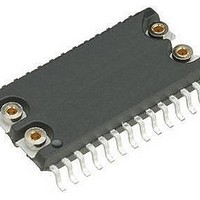M41T256YMT7 STMicroelectronics, M41T256YMT7 Datasheet - Page 21

M41T256YMT7
Manufacturer Part Number
M41T256YMT7
Description
Real Time Clock Serial 256K (32Kx8)
Manufacturer
STMicroelectronics
Datasheet
1.M41T256YMT7.pdf
(30 pages)
Specifications of M41T256YMT7
Function
Clock, Calendar
Rtc Memory Size
32768 B
Supply Voltage (max)
5.5 V
Supply Voltage (min)
4.5 V
Maximum Operating Temperature
+ 70 C
Minimum Operating Temperature
- 25 C
Mounting Style
SMD/SMT
Rtc Bus Interface
Serial
Package / Case
SO-44
Time Format
HH:MM:SS:hh
Lead Free Status / RoHS Status
Lead free / RoHS Compliant
Available stocks
Company
Part Number
Manufacturer
Quantity
Price
Company:
Part Number:
M41T256YMT7F
Manufacturer:
STMicroelectronics
Quantity:
135
3.8
3.9
The first involves setting the clock, letting it run for a month and comparing it to a known
accurate reference and recording deviation over a fixed period of time. Calibration values,
including the number of seconds lost or gained in a given period, can be found in Application
Note AN934: TIMEKEEPER CALIBRATION. This allows the designer to give the end user
the ability to calibrate the clock as the environment requires, even if the final product is
packaged in a non-user serviceable enclosure. The designer could provide a simple utility
that accesses the calibration byte.
The second approach is better suited to a manufacturing environment, and involves the use
of the FT pin. The pin will toggle at 512Hz, when the stop bit (ST) is '0,' and the frequency
test bit (FT) is '1.'
Any deviation from 512Hz indicates the degree and direction of oscillator frequency shift at
the test temperature. For example, a reading of 512.010124Hz would indicate a +20 ppm
oscillator frequency error, requiring a –10 (XX001010) to be loaded into the calibration byte
for correction. Note that setting or changing the calibration byte does not affect the
frequency test output frequency.
The FT pin is an open drain output which requires a pull-up resistor to V
operation. A 500 to 10k resistor is recommended in order to control the rise time. The FT bit
is cleared on power-down.
Battery low warning
The M41T256Y automatically performs battery voltage monitoring upon power-up. The
battery low (BL) bit, bit D7 of day register, will be asserted if the battery voltage is found to
be less than approximately 2.5V. The BL bit will remain asserted until completion of battery
replacement and subsequent battery low monitoring tests, during the next power-up
sequence.
If a battery low is generated during a power-up sequence, this indicates that the battery is
below approximately 2.5 volts and may not be able to maintain data integrity in the SRAM.
Data should be considered suspect and verified as correct. A fresh battery should be
installed. The battery may be replaced while V
The M41T256Y only monitors the battery when a nominal V
applications which require extensive durations in the battery back-up mode should be
powered-up periodically (at least once every few months) in order for this technique to be
beneficial. Additionally, if a battery low is indicated, data integrity should be verified upon
power-up via a checksum or other technique.
Preferred power-on/battery attach defaults
See
Table 4.
1. X = Undetermined; UC = Unchanged
Battery attach or initial power-up
Power-cycling (with battery)
Table
4, below.
Condition
Preferred default values
WC
0
0
TEB
UC
X
CC
(1)
is applied to the device.
TB
UC
X
(1)
CC
is applied to the device. Thus
FT
0
0
CC
ST
UC
for proper
X
(1)
SLP
UC
X
21/30
(1)













